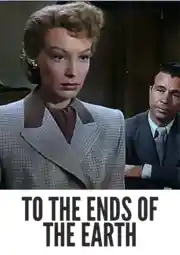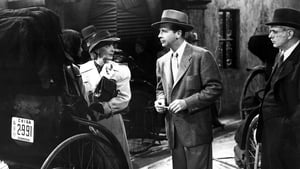Contact: [email protected]
Video Sources 0 Views

To the Ends of the Earth Colorized 1948: Best Cinematic Masterpiece Revived
Synopsis
[ez-toc]




Introduction
In the annals of classic cinema, there exists a timeless allure to old movies, a captivating charm that transcends generations. “To the Ends of the Earth Colorized 1948,” a film noir thriller directed by the maestro Robert Stevenson, stands as a testament to the enduring magic of old films. Recently, this cinematic gem has undergone a transformation, emerging from its original black-and-white cocoon to dazzle audiences in a vibrant colorized version. In this article, we delve into the depths of this revitalization, exploring the plot, performances, and the artistic choices that have brought new life to this classic.
Read Media File Transfer Agreement: Terms and Conditions
Read FAQ
The Story Unfolded: Plot and Characters
“To the Ends of the Earth Colorized 1948” weaves a tale of intrigue and danger that spans the globe. Set against the backdrop of a dangerous drug smuggling operation, the film takes Commissioner Lum Chi Chow, a determined U.S. Treasury agent, on a perilous journey from the bustling streets of Shanghai to the ancient landscapes of Egypt and the gritty underworld of New York. The narrative unfolds like a classic film noir, with shadowy characters and unexpected twists keeping the audience on the edge of their seats. The drug smuggling plot serves as the backbone, but it’s the characters and their interactions that truly elevate the film to greatness.
Commissioner Lum Chi Chow, portrayed with gravitas and intensity, becomes the linchpin holding the intricate plot together. The character’s pursuit of justice becomes a riveting exploration of morality and the lengths one is willing to go to in the face of darkness. The international settings add layers of complexity to the narrative, creating a visually stunning backdrop for the unfolding drama. From the exotic allure of Shanghai to the timeless mystique of Egypt, each location becomes a character in its own right, contributing to the film’s immersive experience.
From Black-and-White to Color: The Art of Revitalization
The transition from black-and-white to color is a delicate art, and “To the Ends of the Earth Colorized 1948” masterfully exemplifies the potential of colorization technology. The restoration process involved meticulous attention to detail, ensuring that the vibrant colors did justice to the film’s original aesthetic. While purists may question the necessity of colorization, arguing that it alters the intended viewing experience, the artistic choices made in this process have undeniably breathed new life into the classic.
The visual aesthetics of the colorized version evoke a sense of nostalgia while offering a fresh perspective on the film. The once monochromatic scenes now pulsate with life, and the film’s noir elements are accentuated by the interplay of light and color. It’s a testament to the advancements in technology that allow us to experience old films in a way that feels both familiar and contemporary.
However, the debate surrounding colorization is not new. Traditionalists argue that it jeopardizes the preservation of the original artistic intent, diluting the essence of the black-and-white era. Yet, proponents assert that colorization opens the doors for a wider audience, making classic films more accessible and engaging for contemporary viewers. “To the Ends of the Earth Colorized 1948” enters this conversation as a striking example of how the marriage of technology and artistry can enhance, rather than diminish, the cinematic experience.
The Director’s Vision: Robert Stevenson
At the helm of this cinematic journey is the visionary director Robert Stevenson. Known for his versatility and keen storytelling instincts, Stevenson’s directorial style brings a unique flavor to “To the Ends of the Earth Colorized 1948.” His ability to balance the tension of a thriller with the emotional depth of the characters is evident throughout the film. Stevenson’s skill in navigating the complexities of the plot ensures that the audience is not only entertained but also emotionally invested in the unfolding drama.
Stevenson’s contribution to the film’s success lies not only in his narrative prowess but also in his directorial choices that seamlessly blend with the colorization process. The film becomes a canvas for his vision, with each frame a carefully crafted piece of art that tells a story beyond the dialogue and plot. Stevenson’s impact on the film’s legacy is undeniable, solidifying “To the Ends of the Earth Colorized 1948” as a testament to his directorial brilliance.
Bringing Characters to Life: Stellar Performances
Central to the film’s success are the stellar performances of the cast, led by Dick Powell as Commissioner Lum Chi Chow and Signe Hasso in a pivotal supporting role. Powell’s portrayal of the determined U.S. Treasury agent is a tour de force, capturing the essence of a man caught in the crossfire of duty and personal conviction. His nuanced performance adds layers to the character, making Commissioner Lum Chi Chow a memorable and relatable protagonist.
Signe Hasso, in her supporting role, brings depth and complexity to the narrative. Her on-screen chemistry with Powell enhances the emotional resonance of the film, adding a layer of humanity to the noir atmosphere. The supporting cast, comprised of seasoned actors of the era, further contributes to the immersive experience, creating a tapestry of performances that elevates “To the Ends of the Earth Colorized 1948” beyond its genre conventions.
Revisiting a Classic: Release Reception and Legacy
Upon its initial release, “To the Ends of the Earth Colorized 1948” received both critical acclaim and commercial success. Audiences and critics alike were captivated by the gripping plot, stellar performances, and the film’s ability to transport them to different corners of the world. The box office performance was commendable, solidifying the film’s status as a classic Hollywood success.
As the years passed, the legacy of the film endured, earning a place among the pantheon of cinematic masterpieces. The decision to colorize this classic was met with skepticism initially, but the enduring charm of the film coupled with the advancements in colorization technology has silenced many critics. Classic Hollywood film enthusiasts, in particular, have embraced the effort to breathe new life into old movies like “To the Ends of the Earth Colorized 1948,” recognizing it as a homage to the golden era of cinema.
The Significance of Experiencing the Colorized Version
The release of the colorized version of “To the Ends of the Earth Colorized 1948” holds profound significance in the realm of classic cinema preservation. While purists may argue that colorization alters the original viewing experience, the reality is that it opens the door for a new generation of viewers to appreciate these cinematic gems. The colorized rendition provides a bridge between the past and the present, making classic films more accessible to audiences who may be hesitant to engage with black-and-white cinema.
The preservation of these films, not just as relics of a bygone era but as living, breathing works of art, is essential. Colorization allows for a fresh perspective, encouraging viewers to engage with the material in a way that feels contemporary. It is a delicate balance between preservation and adaptation, and “To the Ends of the Earth Colorized 1948” navigates this terrain with finesse.
How to Watch “To the Ends of the Earth Colorized 1948”
For those eager to embark on this cinematic journey, the colorized version of “To the Ends of the Earth 1948” is available on various platforms. Popular streaming services, recognizing the appeal of classic films, have made it possible for audiences to experience the film from the comfort of their homes. Additionally, for enthusiasts who appreciate the tangible charm of physical media, DVD and Blu-ray releases offer a chance to own a piece of cinematic history.
Whether through the convenience of streaming or the nostalgia of physical media, “To the Ends of the Earth Colorized 1948” awaits, ready to transport audiences to a world where shadows dance, and characters come to life in a kaleidoscope of colors.
In Conclusion
In the realm of classic cinema, “To the Ends of the Earth Colorized 1948” emerges as a must-see movie experience. The marriage of the film noir genre with the artistry of colorization technology breathes new life into this cinematic masterpiece. As we traverse the dangerous world of drug smuggling with Commissioner Lum Chi Chow, the vibrant palette adds layers to the narrative, creating an immersive experience that captivates both old film aficionados and newcomers alike.
The significance of experiencing the colorized version goes beyond the debate of preservation; it’s about making classic films relevant to contemporary audiences. “To the Ends of the Earth Colorized 1948” invites viewers to appreciate the craftsmanship of a bygone era while acknowledging the value of adapting these treasures for a new generation. As you embark on this cinematic journey, prepare to be enthralled by the allure of a classic revived, a testament to the timelessness of storytelling and the enduring magic of old movies.













